Traeger vs. Weber:您应该购买哪个颗粒烤架?
We compared two popular pellet grills to see how they stack up.
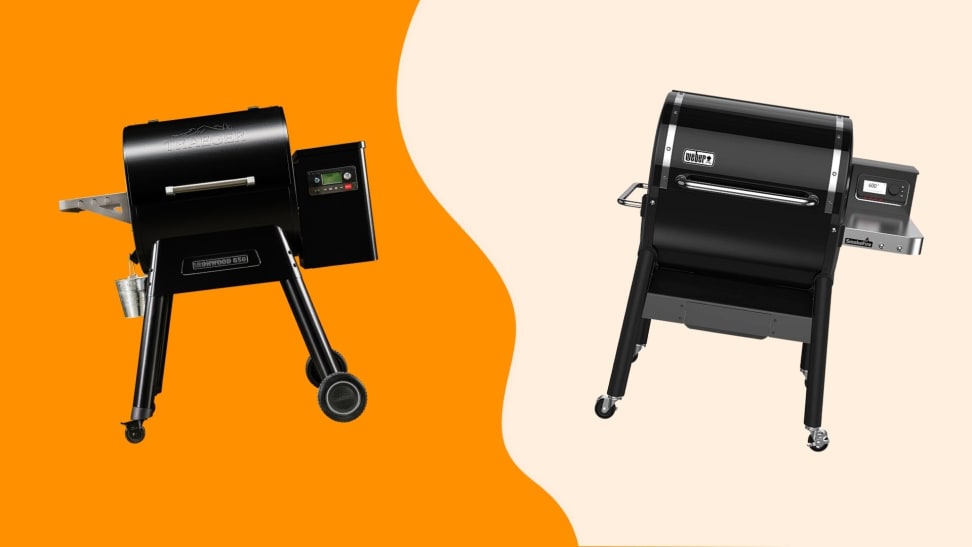 Credit: Reviewed / Traeger / Weber
Credit: Reviewed / Traeger / Weber
Recommendations are independently chosen by Reviewed’s editors. Purchases you make through our links may earn us a commission.
Traeger has been the leader inpellet grillsfor decades. Until 2006, they held an exclusive patent to the pellet grill design, so they’ve had a long time to perfect their process. Of course, you can’t talk about grills without mentioning Weber, a brand that’s achieved high success because of their reliable designs and superior customer service.
We’ve tested several Weber grills over the years, includinggas, charcoal, and portable grills, and we’ve always been impressed. Almost every Weber grill that’s passed through our hands has made its way to the top of the list, and we’ve named itsgas grillsour top choice for both standard and便携式烤架.
So when Weber announced a new line of pellet grills—theWeber Smokefire Ex4and EX6—we couldn’t wait to get our hands on them. We put it head-to-head with theTraeger Ironwood 650, our top pick forpellet grillsto see if the SmokeFire could dethrone the king.
你为什么买一粒烧烤吗?
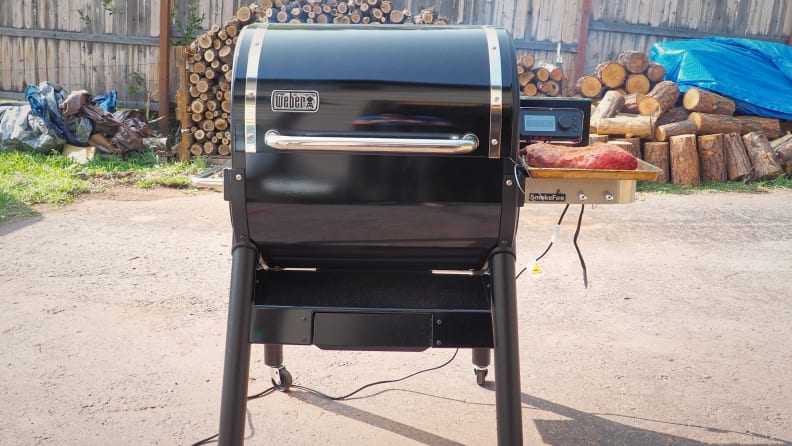
Wood pellet grills are electric-powered but fueled by wood pellets, offering the same flavor benefits as charcoal grills.
Pellet grills are different from other grills because they heat with dual fuel. The fire inside the grill is produced by wood pellets, which are delivered to the fire pot by an electric-powered auger. That means there’s no need to fiddle around with dials or vents to reach the desired temperature, creating a set-it-and-forget-it functionality that’s missing from other grills. Simply ensure the hopper is full of pellets, select the temperature from the control panel, and let the grill do all the work.
当在低和慢的烹饪温度下使用时,颗粒会吸烟和闷烧,形成类似于在木头或木炭上烧烤的风味。它们也可以在较高的温度下使用,大多数制造商在400°F至500°F之间的最高温度下限制。这离气体烤架(通常在550°F上盖)不远,但是使用散热器板可防止大多数颗粒烤架上的直接灼热和烤架。
How we tested
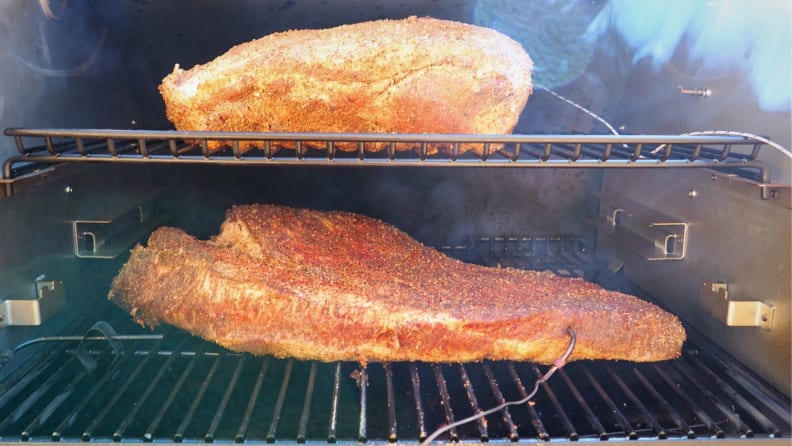
We wanted to see how the Traeger Ironwood 650 could handle cooking tough cuts of meat at low temperatures.
We put the Traeger Ironwood 650 head-to-head with the Weber SmokeFire EX4. The two grills have similar grilling surface areas and both feature Wi-Fi-connected apps, so the comparison between the two came pretty close to apples-to-apples. After cycling the grill on and off dozens of times, smoking a whole packer brisket at 250°F, and cooking a dozen chicken wings at 500°F, we had a pretty good idea of how each grill functioned.
Read the full testing protocol here.
Price
When it comes to price, the Weber SmokeFire definitely wins. The SmokeFire EX4 is currently available for $799. Compare that with the Traeger Ironwood 650’s almost $1,200 price tag, and the former definitely starts to look more attractive.
Traeger does sell theirPro Series grillsat a lower price point, starting at $799. We didn’t test these grills, though, because they have a smaller grilling surface area, a slightly smaller hopper capacity, and they lack several of the features of the more advanced Ironwood series.
Pellets
Both grills recommend using proprietary pellets, and they have a variety of flavor options. In the case of the SmokeFire, we definitely recommend using Weber’s brand. Their pellets are slightly smaller than generic pellets, so the larger pellets might get stuck in the auger and cause issues down the line.
Weber pelletswin here too as they’re slightly less expensive, selling for $16.99 per 20-pound bag. You can buy them in apple, cherry, hickory, and mesquite flavors. Weber also has a “grillmaster’s blend” made with a combination of hickory, maple, and cherry.
Traeger pelletssell for $18.95 per 20-pound bag and come in apple, cherry, hickory, pecan, and mesquite flavors. They also have a “signature blend” made with a combination of hickory, maple, and cherry.
Design
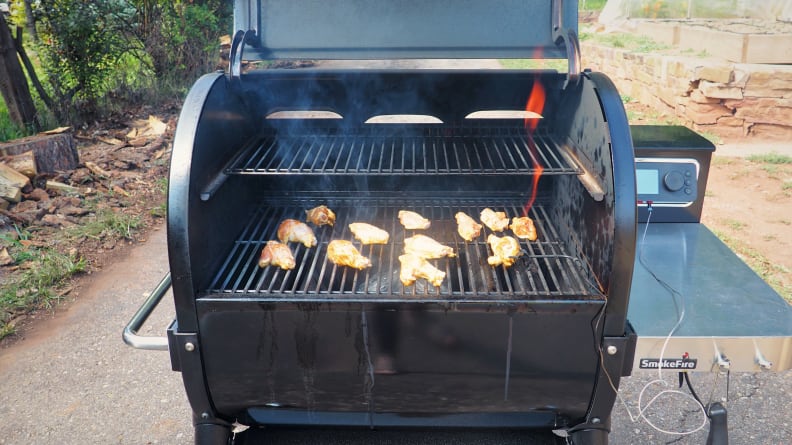
Unlike other pellet grills, the SmokeFire doesn't have a large heat deflector plate, allowing you to sear as well as smoke.
There were features of each grill’s design that we liked and others that we thought could use some work, so we’ll call the design a draw between the two pellet grills.
The Weber SmokeFire has a long, barrel-shaped body and a pellet hopper that runs along the backside of the grill. It ditches the classic smokestack, venting the smoke out of the back of the grill to give it a sleek design that looks great on the patio. The control panel is found on the right side above the side table. The grill’s temperature or any of the four meat probes can be adjusted by the dial or by using the Weber Connect app.
Inside the grill are stainless-steel grill grates and a heat deflector plate. Unlike most pellet grills, the deflector plate only covers an 8-inch area over the fire pot, leaving the grill open for smoking or searing. We loved that we could sear on the SmokeFire, but the open design is ripe to start grease fires after smoking fatty meats like brisket or pulled pork one day and cranking it up to 500°F to sear the next. That means it needs to be cleaned thoroughly between sessions.
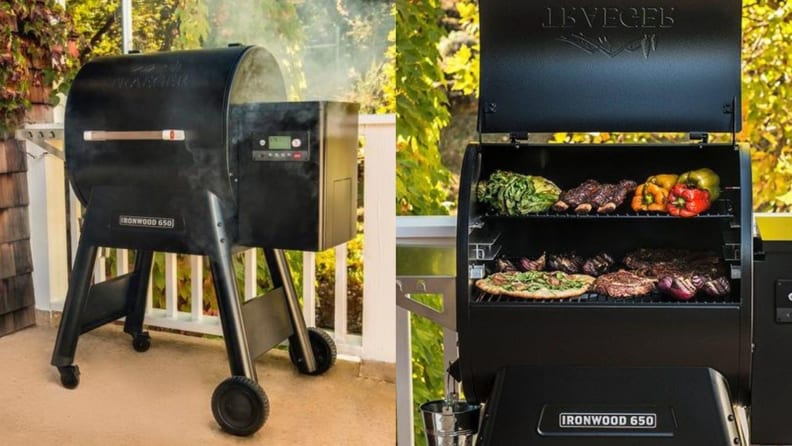
A Traeger grill produces heat by burning pellets made from compressed wood.
The Traeger Ironwood has a classic pellet grill design, with a side table on the left and the pellet hopper on the right. Unlike older Traegers, the Ironwood doesn’t have the smokestack, venting the smoke out of the back of the grill for a cleaner look. The control panel is located on the side of the pellet hopper. This panel looks a little outdated compared to some of the LED control panels we’ve seen on other pellet grills, but you can adjust the temperature of the grill’s temperature and the single probe thermometer with the dial or by using the Traeger WiFIRE app.
The Traeger has a traditional look inside the grill: A heat deflector plate covers the entire surface beneath the stainless steel grates. That means it doesn’t have the ability to sear meats, but it does allow the grill to have an even temperature throughout the grilling area. The heat deflector plate can be covered with aluminum foil or aTraeger grill liner, which makes the grill so much easier to clean.
Grilling space
At first glance, the Weber SmokeFire wins with total grilling space. It features 672 square inches of dual grilling space (432 on the bottom grate and 240 on the adjustable top rack). By comparison, the Traeger has 572 square inches of dual grilling space (418 on the bottom grate and 154 on the top rack).
也就是说,几乎没有温度均nce between the two racks on the Traeger since the entire grill is covered with a heat deflector plate. That allowed us to use the two racks interchangeably, giving us more grilling surface area than at first glance. With the Weber, the heat deflector plate only covers a small portion over the fire pot, so the temperatures varied widely between the two grates. We had to be a little more strategic about the foods that went on each rack to make sure everything cooked evenly.
温度控制和保暖率

Traeger的内置肉探针可以进行校准,因此您可以随着时间的推移获得准确的读数。
Both grills made it super easy to change the temperature settings. They both had Bluetooth- and Wi-Fi-connected apps that allowed you to control the grill’s temperature, set probe thermometer targets, set a timer, activate a smoke setting (SmokeBoost on the Weber and Super Smoke on the Traeger), or turn off the grill remotely.
在温度一致性和热retention, the Traeger wins hands-down. The Ironwood not only preheated more quickly than the SmokeFire, but it also recovered more quickly after opening the lid. The Traeger also held more consistent temperatures throughout the cooking session, only varying 10°F from the set temperature compared to the SmokeFire’s temperature swing at upwards of 50°F.
Finally, the Ironwood’s control panel displayed more accurate temperatures. We found that the SmokeFire didn’t display an accurate grill temperature. It often showed the same number as the grill’s set temperature while an ambient probe proved it was much higher than the setting.
Pellet use and efficiency
两个烧烤架都能在料斗中放一个20磅重的袋子,它们都具有一个简单的卸载门,如果您想更换颗粒的口味,则可以使您清空料斗。韦伯的颗粒料斗沿着烤架的后部奔跑,因此与Traeger的正方形容器相比,它更长,更厚。这使韦伯更难填充,因为目标比方形颗粒料斗更窄。
We it came to fuel efficiency, they were pretty similar. The Weber maybe used pellets slightly faster than the Traeger, but not by much.
wi - fi connectivity and app functionality
两个烤架都有蓝牙和Wi-Fi连接的应用程序,这些应用程序添加了烤架的整体设置和填充功能。您可以在不靠近烤架的情况下控制烧烤炉的温度,当您达到目标温度或烧烤弹的颗粒时,两者都有通知和警报。
The apps were very different in appearance, but they both function well. We loved that each one had built-in recipes with step-by-step instructions, something that will greatly benefit new grillers. We can’t say we preferred one app over the other, so this one’s a draw, too.
Overall performance
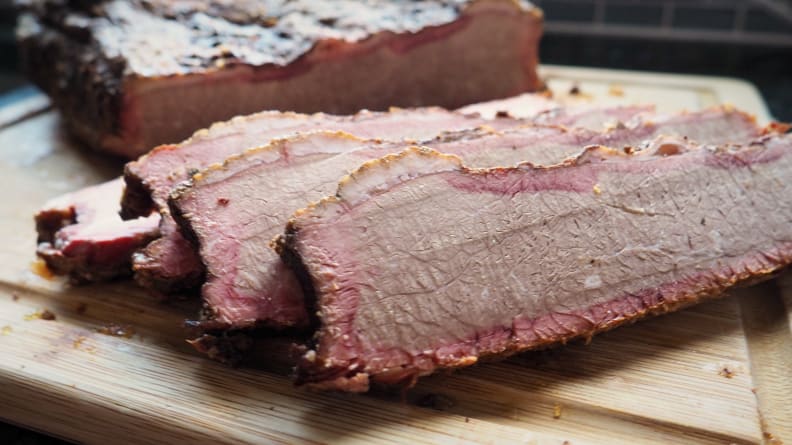
The SmokeFire produced high-quality smoke, creating a delicious brisket with a beautiful smoke ring.
我们在低温和高温下都测试了两个烤架,吸烟牛ket和225°F至250°F的猪肉以及500°F的炸鸡翅膀。Traeger在这两个任务上都表现出色,赢得了这个子弹,而Weber在高温间接热烹饪方面挣扎着。
The SmokeFire’s open design helped it significantly during the low-temperature cooking session. The heat deflector plate only covers a small section above the fire pit, so it allowed more smoke to circulate around the food as it cooked. That created one of the best briskets in the test group! That said, we had to do a lot of manual work to keep the temperature low, since the control panel didn’t always display an accurate ambient temperature. We sometimes had to set the grill at 205°F to achieve 250°F.
When it came to high-temperature cooking, the Weber struggled. That same open design we loved for smoking was a detriment, heating up portions of the grill to higher temperatures than others. We had to use the smaller top rack to get a perfect crisp on the chicken wings, as they burned and cooked unevenly on the bottom rack.
The Traeger nailed it with both the brisket and the wings. At low temperatures, it stayed within 10°F of the set temperature, creating a super juicy brisket. It was able to produce a ton of smoke at low temperatures, and the grill’s internal fan helped circulate the smoke around the brisket. The large heat deflector plate definitely didn’t prevent the brisket from obtaining a robust smoke ring and a smoky flavor.
At higher settings, the grill stayed at remarkably even temperatures throughout the grill. The Ironwood’s Downdraft Exhaust system is designed to move smoke around your food as it cooks, and at high temperatures, this system functioned like the fan on a convection oven. That circulated hot air around the wings, crisping them up just as well as a deep fryer. We cooked wings on both the top and bottom racks, and we couldn’t notice any difference between the two.
Warranty
At first glance, it appears Weber wins here. The SmokeFire is covered by a five-year warranty, while the Traeger is only covered by a three-year warranty. When we dug in, though, we found the SmokeFire’s electrical components, cooking grates, pellet slide, burn pot, heat baffle, pellet grate, and controller bezel are only covered for three years. That means this one is really a wash. Neither warranty is transferable, so they apply to the original owner only.
Weber’s warranty covers material defects, but it doesn’t apply to normal wear and tear (cosmetic damages, discoloration not related to material defects, scratches and dents, surface rust, etc.).
如果不按照操作说明进行操作,包括使用与设备不兼容的燃料,或将其用于食品服务申请,则Traeger的保修是无效的。
And the winner is…
When we put it all together, the Traeger Ironwood is the winner. It was easy to use, held reliable temperatures, and produced fantastic-tasting food at both low and high temperatures. We enjoyed using the Weber, but it was clear that Traeger has had more time in the pellet grill arena to work out some of the kinks we found in the SmokeFire, like inconsistent temperature readings and an open grill design that can create grease fires. That said, the price on the SmokeFire is super attractive, it excelled at creating smoky flavors, and it can sear (something Traeger pellet grills cannot do). If you’re looking for a combination grill/smoker and are on a budget, the SmokeFire certainly fits the bill.
Get the Traeger Ironwood 650 pellet grill for $1,199.99
Get the Weber SmokeFire EX4 pellet grill for $799
The product experts atReviewedhave all your shopping needs covered. Follow Reviewed onFacebook,Twitter, andInstagramfor the latest deals, product reviews, and more.
Prices were accurate at the time this article was published but may change over time.





